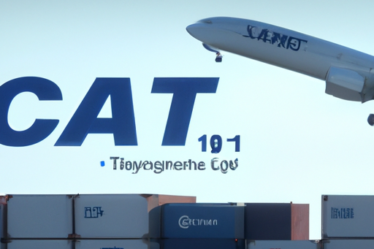
The Impact of Rising Passenger and Cargo Numbers at Hong Kong Airport
Hong Kong International Airport has experienced a significant increase in both passenger and cargo numbers in recent years. This rise in activity has had a profound impact on the airport and the surrounding area. In this article, we will explore the various ways in which the increasing numbers have affected Hong Kong Airport and its stakeholders.
One of the most obvious impacts of the rising passenger and cargo numbers is the increased demand for infrastructure and facilities. The airport has had to expand its terminals and runways to accommodate the growing number of flights and passengers. This expansion has not only improved the overall passenger experience but has also created job opportunities for the local community.
With more passengers and cargo passing through the airport, there has been a boost in the local economy. The increased activity has led to the growth of businesses such as hotels, restaurants, and retail stores in the surrounding area. These businesses have benefited from the influx of tourists and business travelers, contributing to the overall economic development of Hong Kong.
Furthermore, the rise in passenger and cargo numbers has also had a positive impact on the aviation industry as a whole. Hong Kong Airport has become a major hub for international flights, connecting travelers from all over the world. This has not only increased the airport’s reputation but has also attracted more airlines to operate in Hong Kong. As a result, travelers now have a wider range of options when it comes to choosing their flights, leading to increased competition and potentially lower airfares.
In addition to the economic benefits, the increasing numbers have also presented some challenges for Hong Kong Airport. The airport has had to implement stricter security measures to ensure the safety of passengers and cargo. This has required significant investments in technology and personnel, but it is a necessary step to maintain the airport’s reputation as a safe and secure travel hub.
Another challenge that the airport has faced is the need for efficient and sustainable operations. With more flights and cargo, there is a greater demand for fuel and energy. Hong Kong Airport has taken steps to reduce its environmental impact by implementing energy-saving measures and promoting sustainable practices. These efforts not only benefit the environment but also contribute to the airport’s long-term sustainability.
Despite the challenges, the rising passenger and cargo numbers at Hong Kong Airport have brought about numerous opportunities for growth and development. The airport has become a key player in the global aviation industry, attracting both business and leisure travelers. The increased connectivity has also strengthened Hong Kong’s position as a major international financial center.
In conclusion, the impact of rising passenger and cargo numbers at Hong Kong Airport has been significant. The airport has had to expand its infrastructure, leading to economic growth and job creation. It has also faced challenges in terms of security and sustainability. However, the overall impact has been positive, with increased connectivity and opportunities for growth. Hong Kong Airport continues to play a crucial role in connecting people and goods from around the world, contributing to the development of Hong Kong as a global city.
Strategies for Managing Increased Passenger and Cargo Traffic at Hong Kong Airport

Hong Kong International Airport has experienced a significant increase in passenger and cargo numbers in recent years. As one of the busiest airports in the world, it is crucial for the airport authorities to implement effective strategies to manage this growing traffic. In this article, we will explore some strategies that have been put in place to ensure smooth operations and enhance the overall passenger and cargo experience.
One of the key strategies employed by Hong Kong Airport is the continuous expansion and improvement of its infrastructure. The airport has been undergoing various expansion projects to increase its capacity and accommodate the growing number of passengers and cargo. This includes the construction of additional runways, terminal buildings, and cargo facilities. By expanding its infrastructure, the airport can handle more flights and cargo, reducing congestion and delays.
In addition to infrastructure expansion, Hong Kong Airport has also implemented advanced technology and automation systems to streamline operations. For instance, the airport has introduced self-check-in kiosks and automated baggage handling systems, allowing passengers to check-in and drop off their luggage quickly and efficiently. This not only reduces waiting times but also enhances the overall passenger experience.
To further manage the increased passenger traffic, Hong Kong Airport has implemented a comprehensive security system. This includes the use of advanced screening technologies and strict security protocols to ensure the safety of passengers and their belongings. By investing in state-of-the-art security measures, the airport can efficiently process passengers while maintaining a high level of safety and security.
Another strategy employed by Hong Kong Airport is the optimization of its air traffic management system. The airport works closely with air traffic control authorities to ensure efficient aircraft movements and minimize delays. By utilizing advanced technologies and real-time data, the airport can effectively manage the flow of aircraft, reducing congestion and improving overall flight punctuality.
Furthermore, Hong Kong Airport has implemented various measures to enhance the cargo handling process. The airport has dedicated cargo terminals equipped with advanced facilities and equipment to handle a wide range of cargo efficiently. Additionally, the airport has implemented a robust tracking system that allows shippers and consignees to monitor the status of their cargo in real-time. This ensures timely delivery and reduces the risk of loss or damage.
To improve the overall passenger experience, Hong Kong Airport has also focused on enhancing its retail and dining offerings. The airport boasts a wide range of shops, restaurants, and duty-free outlets, providing passengers with a diverse selection of products and services. By creating a pleasant and enjoyable environment, the airport aims to make the travel experience more enjoyable for passengers.
In conclusion, Hong Kong International Airport has implemented various strategies to manage the increased passenger and cargo traffic. Through infrastructure expansion, advanced technology, efficient security systems, optimized air traffic management, and enhanced cargo handling processes, the airport aims to ensure smooth operations and enhance the overall passenger and cargo experience. By continuously improving its services and facilities, Hong Kong Airport remains a leading global aviation hub.
Future Growth Opportunities for Hong Kong Airport Amidst Rising Passenger and Cargo Numbers
Hong Kong International Airport has been experiencing a significant increase in both passenger and cargo numbers in recent years. This growth has opened up a world of opportunities for the airport, as it looks to the future and plans for further expansion and development.
Passenger numbers at Hong Kong Airport have been steadily rising over the past decade. In 2019, the airport handled over 71 million passengers, making it one of the busiest airports in the world. This increase can be attributed to a number of factors, including the growing popularity of Hong Kong as a tourist destination and the city’s status as a major business hub in Asia.
With more and more people choosing to travel to and through Hong Kong, the airport has had to adapt and expand to meet the demand. In recent years, the airport has undergone a number of infrastructure projects to increase its capacity and improve the passenger experience. These projects have included the construction of a new passenger terminal, the expansion of existing terminals, and the addition of new runways.
The rise in cargo numbers at Hong Kong Airport has also been impressive. In 2019, the airport handled over 4.8 million metric tonnes of cargo, making it one of the busiest cargo airports in the world. This growth can be attributed to Hong Kong’s strategic location as a gateway to China and other Asian markets, as well as its excellent air cargo facilities and infrastructure.
The increase in cargo numbers has presented new opportunities for the airport to further develop its cargo handling capabilities. Hong Kong Airport has invested in state-of-the-art cargo facilities, including a dedicated cargo terminal and a logistics center, to meet the growing demand for air cargo services. These investments have helped to attract major logistics companies and strengthen Hong Kong’s position as a global logistics hub.
Looking to the future, Hong Kong Airport sees even more growth opportunities on the horizon. The airport has identified a number of key areas for development, including expanding its network of destinations, attracting new airlines, and increasing its cargo handling capacity. By focusing on these areas, the airport aims to further enhance its position as a leading international aviation hub.
One of the key strategies for future growth is to expand the airport’s network of destinations. Hong Kong Airport is constantly working to attract new airlines and secure new routes to key markets around the world. By offering more flights to more destinations, the airport aims to increase its passenger numbers and further strengthen its position as a major aviation hub in Asia.
In addition to expanding its passenger services, Hong Kong Airport is also looking to increase its cargo handling capacity. The airport plans to invest in new cargo facilities and technologies to meet the growing demand for air cargo services. By doing so, the airport aims to attract more cargo airlines and further establish itself as a global logistics hub.
In conclusion, Hong Kong International Airport is experiencing a period of rapid growth, with rising passenger and cargo numbers. This growth presents a range of future opportunities for the airport, including expanding its network of destinations, attracting new airlines, and increasing its cargo handling capacity. By capitalizing on these opportunities, Hong Kong Airport aims to further enhance its position as a leading international aviation hub.


